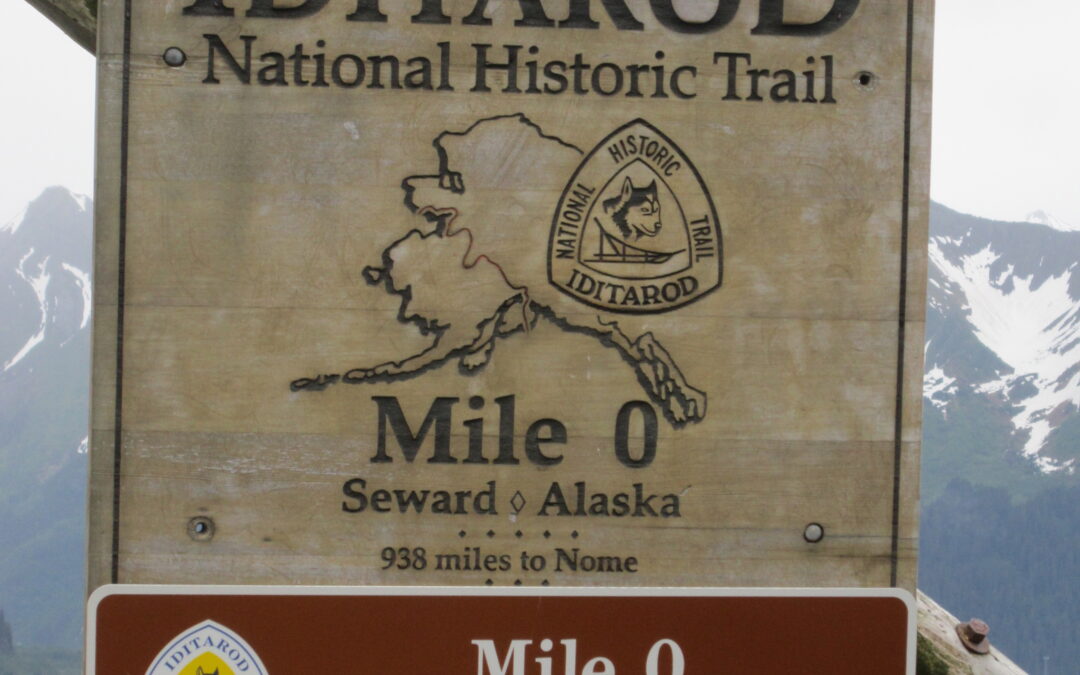FRIDAY, JULY 6, 2012 – GIRDWOOD >> SEWARD
I woke up around 8:00 am, showered, and got ready. I asked T.J. if he wanted to ride the Aleyska Tram up to the top of Mt. Aleyska with me. He declined. The tram moved up the mountain – 2,300 feet – at half speed; it takes skiers up at full speed in the winter. The view was spectacular! There was snow immediately upon stepping off the platform. I saw kettles below. I walked through the Round House and bought a scarf with a native American eagle blessing design.
I rode the tram back down. I walked around the outside of the hotel, snapping pictures of the beautiful flowers against the mountain backdrop.
T.J. was dressed and ready to go when I got back to the room. We packed our bags into the car and drove back to Girdwood. We ate breakfast at the Silver Grizzly before starting our 90-mile trip on Seward Highway, mainly through the Chugach National Forest, to Seward.
Seward (population 4,000), was founded in 1903, It was named after William Henry Seward, President Lincoln’s Secretary of State who engineered the U.S. purchase of Alaska from Russia in 1867. Seward is known as the Gateway to Kenai Fjords National Park.
After checking into the Harborview Inn on Third Avenue in Seward, we drove back up Seward Highway, turned on to Herman Leirer Road, and drove nine miles to the Exit Glacier Nature Center.
We saw several signs warning of bears. We took the half-mile hike up “Edge of the Glacier” trail to Exit Glacier in the Kenai Fjords National Park, one of Alaska’s eight National Parks. There were signs along the way marking the year that the glacier used to extend to that location. It was pretty amazing, but no moose, no bear – Darn!
On the drive back to town, We stopped at Turning Heads Kennel. T.J. rode through the forest on a wheeled dog sled pulled by a team of dogs training for the Iditarod.
Seward is the start of the Iditarod Trail. Seward resident, Mitch Seavey won the Iditarod Trail Sled Dog Race in 2004, finishing the 1,049 mile race in 9 ½ days. Mitch’s father ran and helped organize the first Iditarod. Mitch’s son, Dallas Seavey, won the 1,000 mile Yukon Quest sled dog race in 2011 and the Iditarod in 2012.
We shopped around Seward , enjoyed the murals, and ate somewhere (I don’t recall the name), but I remember that it was not so good.
We should have checked out the Alaska SeaLife Center. We had heard on the radio earlier that day that a baby Beluga Whale had been rescued and was at the Center, but we forgot. The SeaLife Center was closed when we stumbled across it.
We saw the location of the start of the Iditarod. We walked along Resurrection Bay and back up to Fourth Street.
A couple of trucks were outside the Fire Station. There were a lot of people milling around. Back at our hotel, we heard on the news that the Fire Station was the headquarters for the rescue workers looking for a racer who went missing on July 4 during the Mount Marathon Race.
The Mount Marathon Race is the oldest mountain footrace in North America. It started with a bar bet on Independence Day in 1909: who could run up the big peak behind town and back down in under an hour? Al Taylor, a dog musher, took the challenge. After reappearing in the bar just over an hour later, he settled the bet by buying a round of drinks for the house! In 1915, the race up the 3,022-foot mountain became an annual July 4thevent.
For decades, fewer than 10 runners competed in the 4th of July Mount Marathon Race. Popularity for the race swelled in the 1970s. Today, there is a lottery system for race entrants. Bibs were previously limited to 350 men, 350 women, and 200 juniors, but in 2012 the race was expanded to accommodate 400 men and 400 women. Entrants are almost all Alaskans; about 90 percent of the adults are return racers.
While the race is only 3 – 3.5 miles long (the length is not exact because racers choose their own way up and down), it’s very steep with an average grade of 38 degrees. The average speed uphill is 2 mph; downhill is 12 mph. The record time of 43 minutes, 21 seconds was set in 1981 by Bill Spencer.
The race is never canceled due to adverse conditions. In 2012, race day was cold and wet with intermittent fog and more snow on the mountain than usual.
The missing racer was last seen heading up the mountain by a race timer who was heading down after the cut-off for officially finishing the race. The racer was wearing black shorts, a black t-shirt, and a black headband. Temperatures on the mountain were near 50 degrees Thursday afternoon and dropped to near 40 overnight, raising concerns about the missing racer succumbing to hypothermia if still alive on the mountain.
I went to bed early. T.J. roamed around outside the hotel until late, talking on his phone to his girlfriend and worrying his mother. Was T.J. going to be the next person to go missing in Seward?

0 Comments